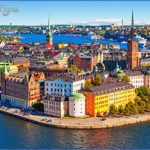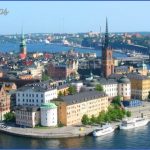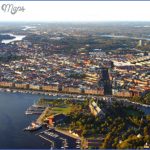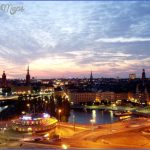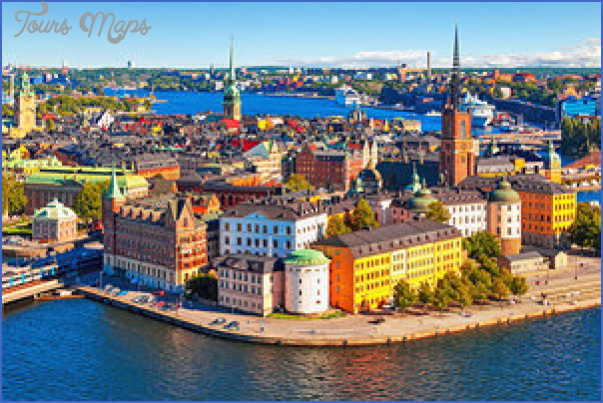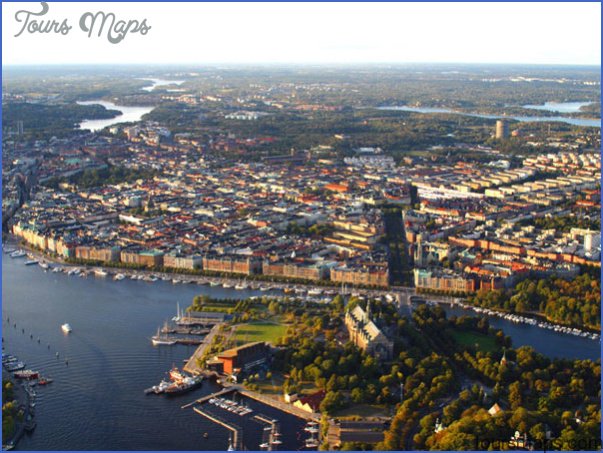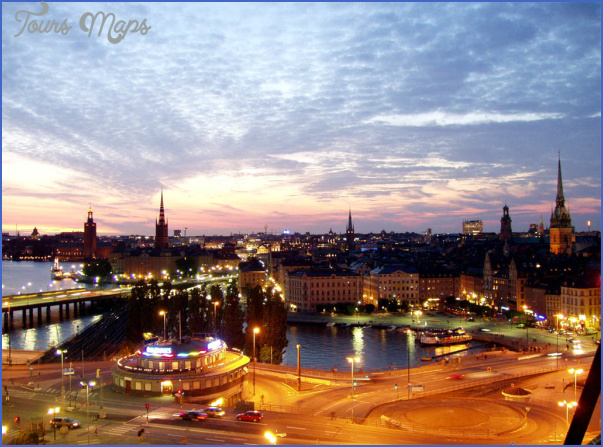HELGEANDSHOLMEN, one of the three islands on which the first settlement developed, is reached by way of the Norrbro. The E end of the island is occupied by a small park, Strdmparterren, with a summer cafe. To the W is the old Parliament Building (1898-1 904), in High Renaissance style, with the Riks-bank (Swedish National Bank) beyond it.
The Norrbro leads on to the island of STADEN; the main part of the old town (Gamla Staden) is here. Straight ahead is the Royal Palace, a Renaissance-style building designed by Tessin the Younger (d. 1728) and completed by his son, K. G. Tessin. The palace occupies the site of an earlier Vasa castle (destroyed by fire in 1697).
The INTERIOR is decorated in Baroque and Rococo style. On the first floor are the apartments occupied by King Oskar II (d. 1 907), the Bernadotte Rooms; on the second floor the State Apartments and the Guest-Rooms; in the S wing the Chapel and the great Hall of Estates. The Museum of Antiquities and the Treasury, with the royal regalia, are open to the public.
Beyond the Palace, to the SW, stands the Cathedral (Storkyrka), as old as Staden itself. Consecrated in 1306, its construction took almost another 200 years, and between 1736 and 1743 it was remodelled in Baroque style. Here the kings and queens of Sweden are married and crowned. Near the altar (reredos of silver and ivory, c. 1 640) is a large Gothic sculpture in polychrome wood of St George and the dragon by the Liibeck sculptor Bernt Notke (d. 1509). It was presented by Sten Sture, Regent of Sweden, after the victory over the Danes in the battle of Brunkeberg (1471). The massive organ is 1 8th c.
To the S of the church is the Stortorg, a square surrounded by 17th and 18th c. buildings. One of the finest of these is the Exchange (Borsen: by Erik Palmstedt, 1778), now occupied by the Swedish Academy and the Nobel Library. In 1 520, the Stortorg was the scene of the Stockholm Bloodbath, when Christian II of Denmark executed 82 leading Swedes in order to strengthen his hold on the country. SE of the Stortorg is the German Church (Tyska Kyrkan: St Gertrude’s), which, more than any other church in the city, preserves the character and style of the 1 7th c. It has a richly gilded altar, an outstanding ebony and alabaster pulpit by Tessin the Elder, a royal pew and an organ presented to the church in 1971 by the German community (the oldest German congregation outside of Germany). To the E of the church, in OsterlSnggatan, is an interesting old restaurant established in 1721, Den Gyldene Freden (Golden Peace). It has associations with the Stockholm poet of the Baroque period, Carl Michael Bellman, among whose best known songs is Fredmans Epistel.
To the W of the German Church, Vaster-ISnggatan runs S, lined by small shops, to the Jarntorg. The old Riksbank building (c. 1670) is believed to be one of the oldest bank buildings in the world. At the NW corner of Staden is the Rid-darhustorg, with a monument to Gustavus Vasa. On the N side of the square, in the Old Town Hall (Bondeska Palatset, 17th c.), is the Supreme Court (Hogsta Domstolen). Here, too, is the Knights’ House (Riddarhuset), in a Baroque style which shows Dutch influence (by Justus Vingboons and Simon de la Vallee, 1641-74). The Knights’ Hall, with the coats of arms of all the Swedish noble families, was, until 1866, the meeting-place of the Estate of the Nobility. From the W side of Riddarhustorg, a bridge leads on to the little island of RID-DARHOLMEN. In Birger Jarlstorg stands a column bearing a statue of Birger Jart, the founder of Stockholm, and also the 1 5th c. Birger JarTs Tower (Birger Jarls-torn), from which there are fine views of Lake Malar and the Town Hall. Also in the square is the High Court (Svea Hovratt), housed in the old Wrangel Palace (c. 1650), with a round tower which is a relic of Stockholm’s earliest fortifications. On the S side of the square stands the Riddarholm Church (Rid-darholmskyrkan), originally belonging to a Franciscan friary but extensively altered in later centuries. The cast-iron steeple (1 841), 90 m (295 ft) high, is a prominent landmark. Since 1807, the church has been used for funerals and memorial services only; it is the burial-place of Swedish monarchs.
Sightseeing in Stockholm Photo Gallery
Maybe You Like Them Too
- The Best Cities To Visit in The World
- World’s 10 Best Places To Visit
- Coolest Countries in the World to Visit
- Travel to Santorini, Greece
- Map of Barbados – Holiday in Barbados

